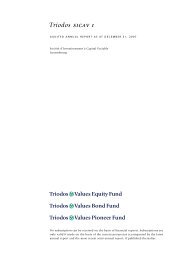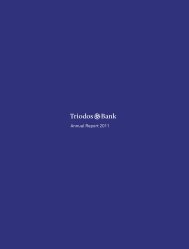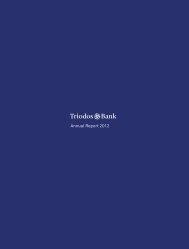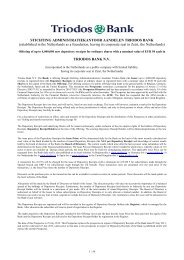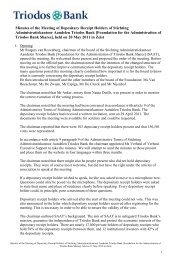TlB Annual Report 2009 - Triodos Bank
TlB Annual Report 2009 - Triodos Bank
TlB Annual Report 2009 - Triodos Bank
You also want an ePaper? Increase the reach of your titles
YUMPU automatically turns print PDFs into web optimized ePapers that Google loves.
‘dry runs’ for all teams. There is a functional<br />
reporting line to Group Operational Risk<br />
Management to ensure the overall operational<br />
risk profile of the organisation.<br />
For calculating operational risks in accordance<br />
with Basel ii, the Basic Indicator Approach is<br />
used. The revised operational risk framework is<br />
in line with the principles mentioned in the<br />
Sound Practices for the Management and<br />
Super vision of Operational Risk. These sound<br />
practices are not a requirement of the Basic<br />
Indicator Approach, but supports more advanced<br />
methods. They give guidelines to the<br />
qualitative implementation of operational risk<br />
management and are advised by the <strong>Bank</strong> of<br />
International Settlements.<br />
CREDIT RISK<br />
Credit risk relates primarily to counterparty’s<br />
potential inability to meet its obligations towards<br />
the <strong>Bank</strong> and the losses the <strong>Bank</strong> might incur as<br />
a result. This counterparty risk concerns both<br />
payment arrears and negative value changes due<br />
to a counter party’s lower credit rating. Credit<br />
risk also includes concentration risk in the<br />
credit portfolio, which is the risk the <strong>Bank</strong> faces<br />
that a particular event may result in a company<br />
or a group of associates failing to meet their<br />
obligations towards the <strong>Bank</strong>. The risk re lates<br />
to all of the <strong>Bank</strong>’s assets: company loans,<br />
deposits with financial institutions and bonds.<br />
<strong>Triodos</strong> <strong>Bank</strong> manages credit (counterparty) risk<br />
and concentration risk from two perspec tives:<br />
• at the individual level per borrower focusing<br />
on the direct relation with the customer<br />
• at portfolio level in order to manage the<br />
concentration of risks per sector, country or<br />
region;<br />
LOANS TO CUSTOMERS<br />
Loans are extended to businesses and projects<br />
in sectors that contribute to achieving <strong>Triodos</strong><br />
<strong>Bank</strong>’s mission. Given that this involves a small<br />
number of sectors, higher sector concentration<br />
is inherent to the loans portfolio. Concentration<br />
on the existing sector is acceptable because the<br />
<strong>Bank</strong> has considerable expertise in them and<br />
actively invests in increasing knowledge about<br />
them within the organisation. Risk is also<br />
reduced by the high quality of securities<br />
(collateral) against outstanding loans and the<br />
spread of the portfolio in the different countries.<br />
Outstanding loans per sector in <strong>2009</strong><br />
The main sectors are:<br />
Nature & Environment (50%)<br />
Culture & Welfare (26%)<br />
Social business (19%)<br />
Others (5%)<br />
NATURE & ENVIRONMENT (50%, 2008: 47%)<br />
This sector consists of renewable energy pro jects<br />
such as wind and solar power and hydro electric<br />
projects. It also includes organic agri culture, and<br />
projects across the entire agricultural chain, from<br />
farms, processors and wholesale companies to<br />
natural food shops. Environmental technology,<br />
such as recycling companies and nature conservation<br />
projects, is also represented.<br />
SOCIAL BUSINESS (19%, 2008: 21%)<br />
This sector includes loans to traditional<br />
businesses and innovative enterprises and<br />
service providers with clear social objectives,<br />
such as social housing, and loans to fair trade<br />
business.<br />
CULTURE & WELFARE (26%, 2008: 30%)<br />
This sector covers loans to organisations<br />
working in education, retreat centres, religious<br />
groups and artists. It also covers health care<br />
institutions including care for people with<br />
learning disabilities.<br />
Lending is primarily the responsibility of local<br />
branches, which are closest to their customers.<br />
Limits are imposed and regular reports to the<br />
group credit risk department agreed to manage<br />
the risk concentration in the sectors <strong>Triodos</strong><br />
<strong>Bank</strong> is active in. Limits are also considered<br />
and agreed on a case-by-case basis.<br />
Summary of outstanding loans per branch in <strong>2009</strong><br />
The Netherlands (35%)<br />
Belgium (21%)<br />
United Kingdom (17%)<br />
Spain (23%)<br />
Germany (4%)<br />
54 TRIODOS BANK - ANNUAL REPORT <strong>2009</strong>




